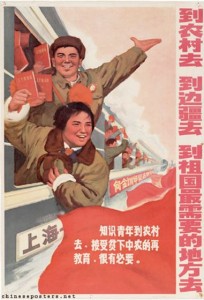The Mao suit dominated fashion during the Cultural Revolution in China (1965-1968) not because it was a “fashionable” outfit, but rather because of its denotation of support for Mao and his ideals. Mao’s Cultural Revolution was motivated by a “power struggle” towards the top of the party system. However, although Mao established The Great Leap Forward, the movement was powered by the massive amount of students and young adults supporting Mao’s ideas. When the Cultural Revolution was still just a thought, a group of students openly denounced their school administration for repressing the students’ voice in a letter to Mao, later labeling themselves as “the Red Guards of Mao Zedong Thought”. This established the term “Red Guard” which is greatly affiliated with the Mao suit. Not long after, the Mao suit became the uniform and fashion that defined the Red Guards. The reason many of Mao’s supporters were young is because young people were intrigued by the freedom they were given by joining the Red Guard. Not only that, but also younger citizens were more likely to follow their friends and fellow classmates in fear of being left out of this trend. And with the Mao suit being the dress and uniform of the Red Guard, the Mao suit in fashion spread across China like wildfire.
Please introduce a central argument that addresses the relationship between the CR and the Mao suit
The Mao suit was a very simple dress that sported little to no decorations. Li Li in Uniformed Rebellion, Fabricated Identity: A study of Social History of Red Guards in Military Uniforms during the Chinese Cultural Revolution and Beyond, shows that clothing is a sign of social status, religion, political party, & gender. However, Li states that uniforms that are worn as a group create a group identity. So, taking into account Li’s connotation of a uniform,
The Red Guard’s uniform was more than just a green jacket, a soft cap with a red star, belt, and red arm sleeve. By simply wearing the uniform, it showed to those around that “the urban adolescents not only legitimize their collective action of social rebellion, but also mobilize themselves to be the political frontrunners with the support of Mao.” well composed and hope you could use it as thesis statement

From Keynote Tsui
In the photo above, a train full of young citizens is on its way to the country side as a part of Mao’s Cultural revolution. The viewer’s eye is immediately drawn to the two young adults with their smiling faces out the train windows holding their Mao red books with joy. Both young adults are wearing a Mao suit, however, the young adult on the bottom has white cuffs (possibly fur) and a fur collar on his or her Mao suit. Whereas the young adult above doesn’t have these features on their Mao suit. There seems to be a hair tie in the young adult’s on the bottom hair, which may indicate that this young adult is actually a girl.
what do those visual denotations reflect?
In contrast with Chinese fashion in previous years, the Mao suit was gender neutral. The Mao suit was worn by Women the same way it was worn by Men. This made it hard to differentiate boys from girls, but it shows the underlying idea of Mao that every citizen is equal and is merely just a part of a bigger social/working system. The fact that you can’t tell what gender either of them are for sure shows that the Mao suit was truly gender neutral. Further proving that Mao’s Cultural Revolution was in fact not about individuals, but rather about the larger population as a whole. The smiles on their faces in addition to the red books they are holding displays the blind support that young adults had in Mao Zedong as their leader. The color red is also very dominant in this photo but also in many other photos as well.
if gender is the focal point, please introduce it at the beginning of the paragraph via a topic sentence
